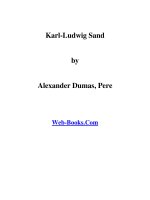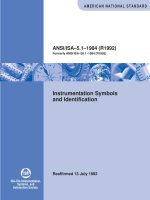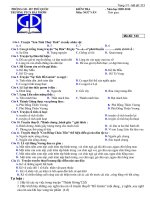rock sand mineral identification
Bạn đang xem bản rút gọn của tài liệu. Xem và tải ngay bản đầy đủ của tài liệu tại đây (2.22 MB, 39 trang )
Rock, Stock and Barrel:
Rocks and Minerals (and Remains of Living Things)
Nab the Criminal
Safe Cracking
Heat-resistant safes are commonly used for
the storage of valuables and important
documents
To prevent heat damage of the contents in
the safe, manufacturers have used a variety
of different materials
In the past, these materials have included
wood chips, cork, cement, asbestos,
gypsum, calcite, and diatomaceous earth.
Safes can be determined to be older than 60
years if they contain natural cement (cement
produced by crude baking of clay-rich
limestone).
Today, the most commonly used insulation materials are
Portland cement, vermiculite, and diatomaceous earth.
Portland cement
(limestone, clay, iron
ore, slag and gypsum
mixed together and
baked)
Vermiculite
Diatomaceous earth
(naturally occurring, but (deposit of silica-shelled
produced commercially diatoms)
by heating mica)
If these substances are found together, forensic scientists
can safely assume that the material is safe insulation (few
other products contain this combination of substances).
Diatomaceous earth, a sediment composed of microscopic
silica shells of diatoms (aquatic algae) was used in safe
insulation up to 1980 (its use since discontinued).
Natural outcrop of diatomaceous
earth in Nevada (lake deposit
about 10 m.y. old)
SEM image of diatomaceous
earth (magnification: approx.
2000x)
Diatoms are used in a manner similar to that used by a
paleontologist.
There are over 100,000 species of freshwater and marine
diatoms known (fossil and modern).
A diatom deposit that is diagnostic of a particular
environment and age serves as a geological fingerprint, due
to the presence of characteristic species and the diversity of
forms in the deposit.
If a safe is forcibly opened and
the insulation layer is damaged,
the dislodged material will be
transferred to the safe cracker.
If diatomaceous earth is found
on the suspect, it provides
unambiguous evidence that the
suspect was at the scene of the
crime
A police officer who was questioning a man suspected of
robbery noted white flecks of material on the man’s shoulders
and head an commented “that’s the worst case of dandruff I
have ever seen.”
Microscopic examination of the “dandruff” revealed 13 different
species of diatoms.
Samples of insulation taken from a recently cracked safe
(robbed the previous day) revealed that it contained
diatomaceous earth and contained the very same 13 species of
diatoms found on the suspect.
This evidence led to the suspect’s arrest and subsequent
conviction.
Note: species identification of plant pollen on transferred soil
has been used in a similar way as diatoms.
Southern Maryland
In a similar case in southern Maryland, two safes were
broken into (one in a restaurant, and the other in a movie
theatre).
Two suspects were apprehended after the incidents took
place
One suspect admitted to the crimes and claimed that the
other suspect to was innocent.
Examination of the pant cuffs of the supposedly innocent
suspect was later found to retain cement particles that
matched the cement-type insulation of the restaurant safe.
Vermiculite mica was found in the car of the “innocent”
suspect. This was the same type of material used as
insulation in the movie theatre safe.
Were it not for mineral evidence, it is likely that the second
suspect would have “walked”.
Cement particles in pant cuffs
Vermiculite particles in car
Heavy minerals
Every sand deposit has small amounts heavy minerals (minerals that are
more than 2.8 times as heavy as an equal volume of water). Many heavy
minerals are resistant to physical weathering and erosion, can therefore
withstand sediment reworking.
Some heavy minerals also have variable properties that can accurately
indicate their ultimate source.
In the lab, heavy minerals are separated from light minerals in heavy
liquids and mounted on glass slides for examination.
Koklas Case
In January, 1968, the body of a man named Andreas
Koklas was discovered along a roadside in Australia,
apparently a victim of murder
The prime suspect was a man named Da Costa who had
travelled with the victim from Melbourne to Mount Isa.
Body
Mt. Isa
Da Costa claimed that they had an argument, that he left
Koklas at Mt. Isa, and took some of his possessions
The possessions included a pair of bloodstained shorts
with sand grains adhering to the blood residue.
Mount Isa was about 500 km east of where the body was
discovered but it was suspected that the shorts had been
removed from the body where the body had been found.
Investigators examined heavy minerals in sand samples from
the shorts and the crime scene.
The types of heavy mineral grains derived from the shorts
(particularly grains of tourmaline with a distinctive chemical
composition) matched more closely to the sand at the
location where the body was found than at Mt. Isa.
After the first court hearing, the suspect admitted to have
murdered the victim at the location where the body was
found.
tourmaline
Theft
In April, 1997, the San Diego County, District Attorney
asked geoscientists Brad Less, Tanja Williamson and
Robert Graham to study material associated with the theft
of $40,000 work of stolen palm trees
The owner raised the exotic trees from seed using a
unique potting soil he purchased in bulk
Investigators collected ten
samples of the potting soil from
tree roots left in the victim’s
yard.
From the yard of the suspect’s
home, they collected soil
samples from root balls of 33
palm trees as well as three
samples of native soil from the
yard.
The suspect had 7 species of palm
trees in his yard.
The victim had raised all but one of
these species Phoenix roebelenii (so
those trees of this species could not
have been stolen from him).
Samples from the 7th species
(Phoenix roebelenii) served as
controls in the study.
Examiners used several methods in
their study, including carbonate
determination, colour and particlesize analyses, and mineralogical
identification.
Phoenix roebelenii
The ratio of light to heavy
minerals was determined
and the heavy ones
examined more closely.
300 heavy mineral grains
were counted.
Heavy minerals included
hornblende, biotite, zircon,
epidote and opaque
minerals such as one
would expect in potting
soil from weathered
granite.
Example of diversity of heavy
mineral grains in sand
Hornblende, the most common heavy mineral provided the
most useful information.
The examiners concluded that 25 of the suspect’s 33 palm
trees had been planted in potting soil that compared with that
used by the victim.
Analyses accurately discriminated the 6 palm tree species
that investigators knew had not been stolen from the victim.
There was no evidence to show that the remaining species
had come from the victim’s yard.
In a pretial hearing at which prosecutors presented the soil
evidence, the suspect changed his plea from innocent to
guilty.
Substitution Cases
Criminals frequently substitute goods in shipment
with other materials to mimic the weight of the goods.
In most cases, the timing and location of substitution is left
unresolved.
However, the use of rocks as substitution “ballast” can
provide investigators with valuable information on such
practises.
The Ghana gold case
In 1997, a gold shipment worth 3 million dollars was
trucked from placer gold mine of Koforidua, Ghana to
the coastal city of Accra, Ghana.
Koforidua
Accra
The shipment consisted of several crates of placer gold
in canvas bags.
The crates were flown to London for processing, where
they sat in storage for several days without customs
inspection.
A conflict arose over processing costs in England, and it
was decided to do the work in Canada.
Accra to London
The crates were then moved to Amsterdam and stored
(again without customs inspection)…
London to Amsterdam
Accra to London
…then flown to Toronto, Canada
Amsterdam to Toronto
London to Amsterdam
Accra to London
Once in Toronto, Canadian customs tagged the crates and
gave them additional seals, but failed to inspect them.
Finally, a Brinks security vehicle took them to a secure
storage facility and later to the processing company.
When the crates were opened, it was discovered that the
gold had been replaced by sand and ingots of pig-iron (iron
taken directly from a blast furnace).
So where did the switch take place ?
Investigators suspected that Canadians might have been
involved in the substitution.
It was clear, however, that the only secure handling took
place on arrival in Canada (the Canadian seals were still
intact when the crated were opened).
Original crates were reportedly secured with padlocks (but
padlocks had apparently been removed when it arrived in
London, and plastic wrapping was applied).
In addition to the crime, there was the question of liability.
Three different airlines had been used as well as multiple
land carriers and storage facilities.
Who was to pay for the lost gold ?









